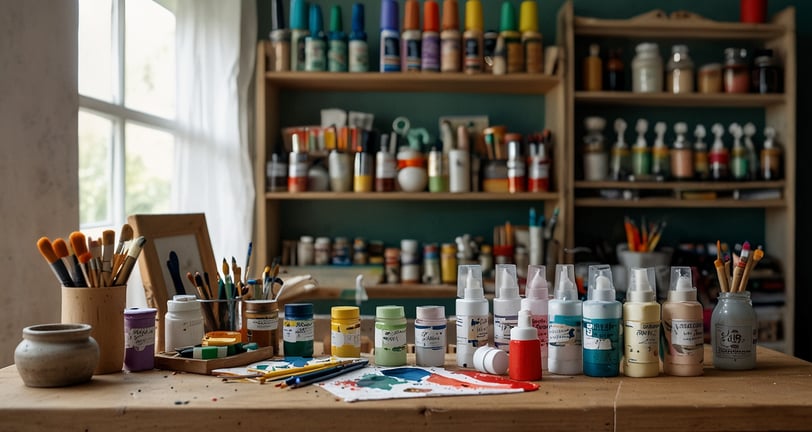Best Paint for Wood Crafts: A Comprehensive Guide
Choosing the best paint for wood crafts is crucial for achieving a professional look. This guide covers top paint options and tips for a flawless finish.


Selecting the right paint for your wood crafts can elevate your projects from amateur to professional. Whether you are an experienced crafter or just starting out, understanding the different types of paint available and their best uses can help you achieve stunning results. In this comprehensive guide, we will explore the top paint options for wood crafts, how to choose the best one for your needs, and techniques to ensure a flawless finish.
Types of Paint for Wood Crafts
1. Acrylic Paint
Acrylic paint is a favorite among crafters due to its versatility, vibrant colors, and ease of use. It's water-based, non-toxic, and dries quickly, making it ideal for various wood crafts.
Pros:
Wide range of colors
Dries quickly
Easy to clean up with water
Non-toxic and safe for kids
Cons:
May require a primer for better adhesion
Can chip if not sealed properly
Best Uses:
Small decorative items
Craft projects with intricate details
2. Chalk Paint
Chalk paint is known for its matte finish and smooth texture. It’s perfect for achieving a vintage or shabby chic look on wood crafts.
Pros:
Requires little to no prep work
Adheres well to most surfaces
Easy to distress for a vintage look
Cons:
Limited color palette
Needs to be sealed with wax or a clear coat to prevent chipping
Best Uses:
Furniture and larger decorative pieces
Projects with a rustic or vintage aesthetic
3. Latex Paint
Latex paint is another excellent option for wood crafts, especially for larger projects. It’s durable, easy to clean, and available in a wide range of finishes, from matte to glossy.
Pros:
Durable and long-lasting
Wide range of finishes
Easy to clean with soap and water
Cons:
Requires proper surface preparation
Longer drying time compared to acrylics
Best Uses:
Furniture
Outdoor wood crafts
Large decorative items
4. Oil-Based Paint
Oil-based paint is known for its smooth finish and durability. It’s ideal for projects that need a hard, glossy finish.
Pros:
Durable and resistant to wear and tear
Smooth, glossy finish
Excellent for detailed work
Cons:
Long drying time
Requires mineral spirits or turpentine for cleanup
Strong odor
Best Uses:
Small decorative items that require a glossy finish
Projects exposed to heavy use
5. Spray Paint
Spray paint is a convenient option for covering large areas quickly. It provides a smooth, even finish and comes in various colors and finishes.
Pros:
Quick application
Even coverage
Available in various colors and finishes
Cons:
Requires a well-ventilated area for use
Can be challenging to control for intricate details
Best Uses:
Large surfaces
Outdoor projects
Projects needing an even, smooth finish
How to Choose the Best Paint for Your Wood Crafts
Choosing the best paint for your wood crafts depends on several factors, including the type of project, desired finish, and where the item will be used. Here are some tips to help you make the right choice:
Consider the Project Size and Detail
Small, Detailed Projects: Acrylic and oil-based paints are ideal for small items and projects that require intricate details.
Large Projects: Latex and spray paint are suitable for larger surfaces due to their ease of application and coverage.
Desired Finish
Matte Finish: Chalk paint offers a matte, vintage look, perfect for rustic or shabby chic projects.
Glossy Finish: Oil-based and spray paints provide a glossy, durable finish, ideal for items that need to withstand wear and tear.
Indoor vs. Outdoor Use
Indoor Projects: Acrylic, chalk, and latex paints are excellent for indoor wood crafts. Acrylic and latex are non-toxic and easy to clean.
Outdoor Projects: Latex and oil-based paints are durable and weather-resistant, making them suitable for outdoor use.
Ease of Use
Beginner-Friendly: Acrylic and chalk paints are easy to use, clean up with water, and dry quickly.
Advanced Techniques: Oil-based paint requires more preparation and cleanup but offers a professional finish for detailed work.
Techniques for a Flawless Finish
Surface Preparation
Proper surface preparation is crucial for achieving a smooth, long-lasting finish.
Clean the Surface: Ensure the wood is clean, dry, and free of dust and grease.
Sand the Wood: Lightly sand the surface to create a smooth base for the paint. Use fine-grit sandpaper and wipe away dust with a damp cloth.
Apply Primer: For best results, apply a primer to help the paint adhere better and enhance the finish. This step is especially important for acrylic and latex paints.
Painting Techniques
Use Thin Layers: Apply thin, even coats of paint to avoid drips and achieve a smooth finish. Allow each layer to dry completely before adding the next.
Brush Strokes: Use long, even brush strokes to minimize visible brush marks. For larger areas, consider using a roller or sponge applicator.
Detail Work: For intricate details, use fine-tipped brushes and take your time to ensure precision.
Sealing the Paint
To protect your finished project and enhance its durability, apply a clear sealer or topcoat.
Chalk Paint: Seal with wax or a clear coat to prevent chipping and enhance the matte finish.
Acrylic and Latex Paints: Use a clear acrylic sealer to add a protective layer and enhance the color.
Oil-Based Paint: Finish with a polyurethane or varnish to add durability and shine.
Selecting the best paint for your wood crafts involves considering the type of project, desired finish, and usage. Whether you choose acrylic for its versatility, chalk paint for its vintage appeal, or oil-based paint for a durable, glossy finish, the right paint can transform your wood crafts into beautiful, professional-looking pieces. By following the tips and techniques outlined in this guide, you can achieve a flawless finish and enjoy the creative process of woodworking.
